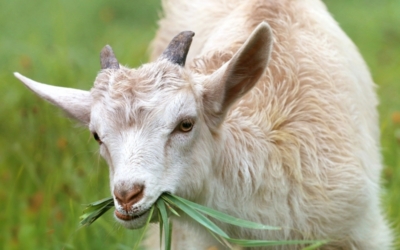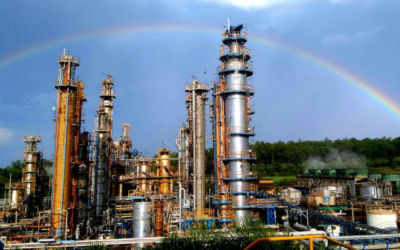From Skyscrapers to Mines – When a Workplace Becomes a Thriving Wildlife Habitat
Workplace structures, like skyscrapers, power plants or mines, are initially built to benefit humans. However, because of the shelter they provide and their proximity to water and food sources, manmade structures like these often end up serving as habitat for native wildlife. Once animals have been spotted living in and around a workplace, how can companies ensure that these incidental habitats are as beneficial to wildlife as possible?
Here are a few species that commonly find habitats in and around workplaces, as well as some of the methods corporations can use to enhance these habitats.
Peregrine falcons on top of the world
Once one of the most widespread birds in the world, peregrine falcon populations in the U.S. were drastically depleted due to the impact of DDT during the 1940s – 60s. It wasn’t until the use of DDT was federally banned and falcon recovery programs like the Chicago Peregrine Program were established that the species began to repopulate. By 1999, the peregrine falcon was no longer considered federally endangered.
Adapting to urban settings was not a challenge for this raptor species, as they prefer tall buildings that resemble their natural cliff habitats. The height of urban skyscrapers and high-rises also makes for a safe space away from other predators. In urban areas, falcons have an abundance of smaller birds such as pigeons to prey on, and cities like Chicago that are located within a major migratory bird flyway make an ideal location for peregrine falcons to hunt.
For building owners who have these birds as tenants, there are several ways to enhance their habitat. Consider changing window washing schedules to avoid disrupting any nests, and install a nest box to give the falcons a secure and protected area for their eggs and young. In order to help support peregrine falcon recovery, Ontario Power Generation set up three nesting boxes at two sites. By protecting the nests from fluctuations in wetness and temperature, which can be extremely detrimental to peregrine eggs, these nesting structures allowed for the successful hatching of eight peregrine falcon chicks.
Birds who take up residence in city centers make for exciting sights for locals and tourists alike. Setting up nest cameras to monitor the birds — and making the live feeds available to the public — creates opportunities to educate community members about these birds.
Manatees in man-made warm water
Another species that has found habitat in manmade structures is the manatee, a migratory aquatic mammal currently listed as a protected species. The warm water discharged from power plant outflows makes an ideal winter habitat for manatees, particularly in Florida.
Manatees were once listed as endangered species due to habitat loss and boat collisions. As natural manatee habitats dwindled, power plant owners began to notice that a large percentage of the remaining population was finding refuge at their outflows. However, because of the impact of thermal pollution on marine life, the EPA proposed regulations that would prohibit the once-through cooling plants that manatees had flocked to. When environmentalists pointed out the detrimental effect these plant closures would have on manatees, the EPA instead exempted older power plants from these regulations and required them to meet environmental standards, including a reduction in the amount of pollutants released.
For power plants that provide habitat to manatees, keeping the warm water flowing is key to supporting the species. Develop outflow disruption plans to make sure that there is no interruption in the water discharge. Opening the facility up to visitors and holding tours or field trips educates the public about manatees as well as the conservation strategies needed to protect them.
Florida Power and Light (FPL) is one such company that turned their manatee habitat into an educational opportunity. They designed a manatee lagoon at their plant in West Palm Beach to provide a protected habitat for manatee herds. Along with the lagoon, FPL also built an educational center where, in addition to providing places to observe the manatees, they host children’s story times, yoga classes, summer camps and more — reaching about 125,000 visitors each year.
Bats finding homes in abandoned mines
Sometimes, workplaces don’t become useful for wildlife until after their use by humans is discontinued. Mines are one particular site of industrialization that, once closed for business, serve as an ideal habitat for bats.
Bats are a crucial part of our ecosystem — through pollination and seed dispersal, they ensure the survival of various plant species, and they also help control insects like mosquitos. Over the past few decades, bat populations have been on the decline due to habitat loss and fragmentation, lack of food sources and diseases such as white-nose syndrome. The environmental benefits of bats, along with the widespread decline of bat populations, are why it’s so important to support bat habitats.
There are an estimated 500,000 abandoned mines in the United States, and 29 native bat species in the U.S. rely on these abandoned mines for habitat. Bats require different habitat needs throughout the year — roosting in the summer, hibernating in the winter, raising their young and stopping over while migrating — and mines can accommodate those needs.
There are several ways to ensure that mine habitats are beneficial for bats. Bat gates, structures made of horizontal steel bars at the entrance to the mine, allow bats to freely enter and exit while keeping humans from disturbing the habitat. Consider the availability of food surrounding the mine habitat as well. For example, the lesser long-nosed bat relies on agave in scrub deserts across the southwestern United States. As part of their ongoing work to support bat populations, Freeport-McMoRan worked with local partners to plant agave at several of their mines in southern Arizona. These kinds of planting events not only ensure abundant food sources for recovering bat populations, but they also serve as educational and community engagement efforts.
Butterflies making rock quarry habitats their own
Much like bats, various species of butterflies have made their homes at extraction sites — this time, at rock quarries. The soil surrounding quarries is often alkaline due to naturally occurring minerals like limestone and chalk. These environments, called calcareous grasslands, are ideal habitats for many butterflies, as alkaline-tolerant plants like birdsfoot trefoil are a food source as well as a place to lay their eggs. Research has shown that about fifty percent of the butterfly species in Europe reside in these kinds of grasslands. As butterflies are ectothermic (or cold-blooded), they need sunny areas to raise their body temperatures, and the plants they feed on also need full sun. Quarries meet this need as well, with their lack of shade trees and rocks that absorb warmth. Since agricultural enterprises and urbanization have encroached on the dry, warm environments that butterflies favor, the warm and calcareous nature of quarries is appealing to them.
Closed or even active quarry sites can encourage butterfly population by planting native milkweed and other butterfly-friendly plants. In their larval stage, many butterflies require a single source of food, so learn about the host plants for the species at your quarry and add them to the site. When employees at a Covia sand mine in Wisconsin committed to creating habitat for the endangered Karner blue butterfly, they focused on planting native wild lupine, the host plant for Karner blue butterfly caterpillars. In addition to the host plants, Covia also planted a variety of forbs to provide food for the adult butterflies and ensured that stormwater ponds nearby provide adequate water.
Co-existing with wildlife often means sharing our buildings and workplaces — and with these strategies, corporate landowners can ensure that workplace habitats support these species.


